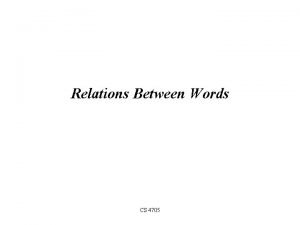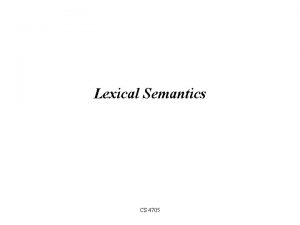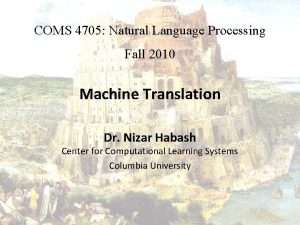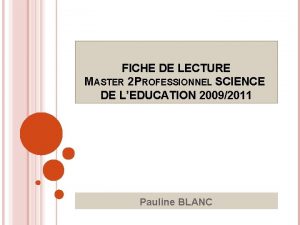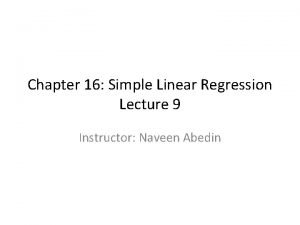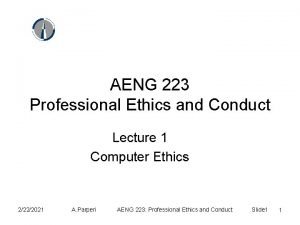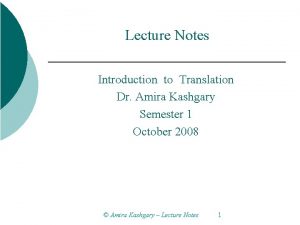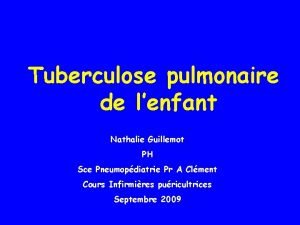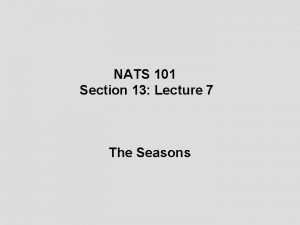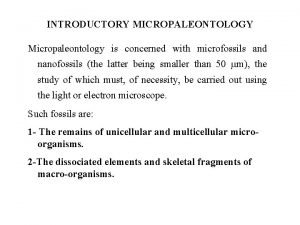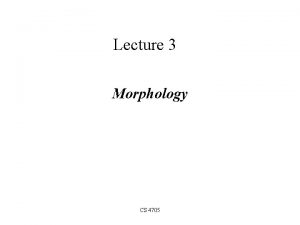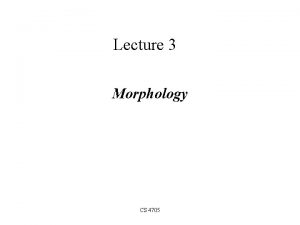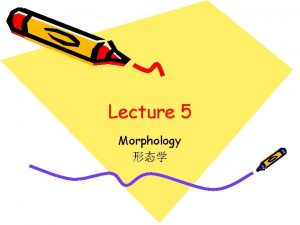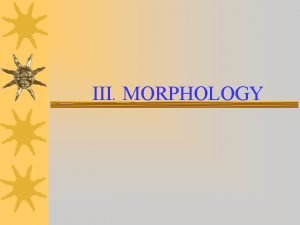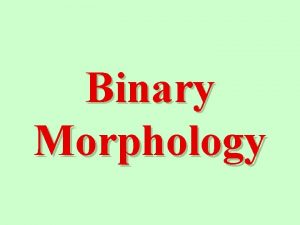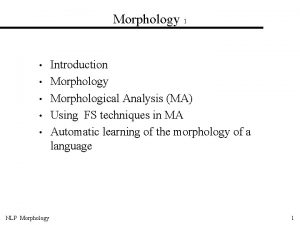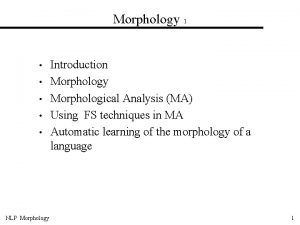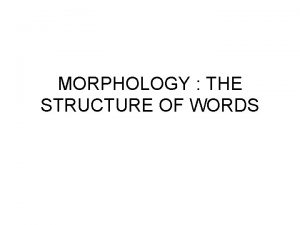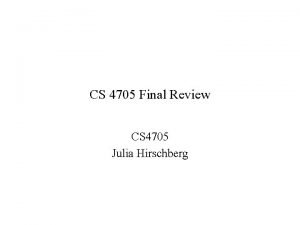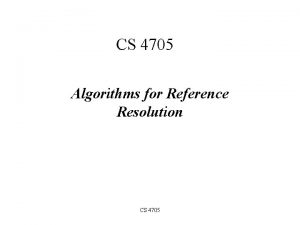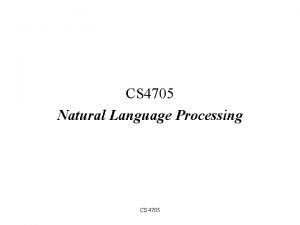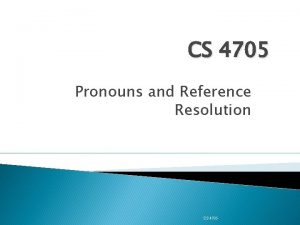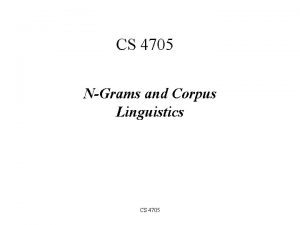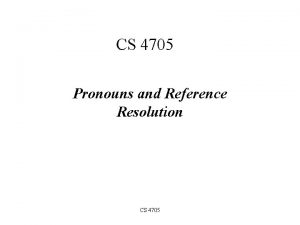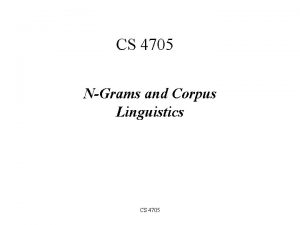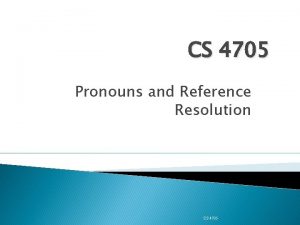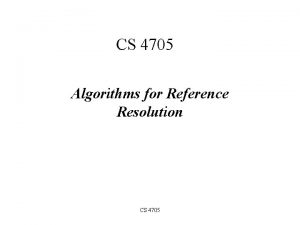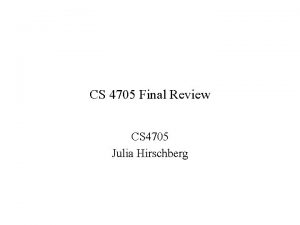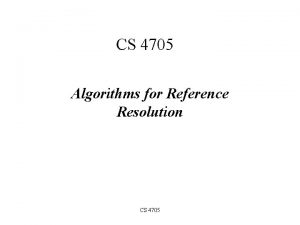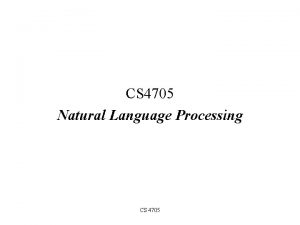Lecture 3 Morphology CS 4705 What is morphology


























- Slides: 26

Lecture 3 Morphology CS 4705

What is morphology? • The study of how words are composed of morphemes (the smallest meaning-bearing units of a language) – Stems – Affixes (prefixes, suffixes, circumfixes, infixes) • Immaterial • Trying • Gesagt • Absobl**dylutely – Concatenative vs. non-concatenative (e. g. Arabic rootand-pattern)

• Multiple affixes – Unreadable • Agglutinative languages (e. g. Turkish, Japanese) vs. inflectional languages (e. g. Latin, Russian) vs. analytic languages (e. g. Mandarin)

English Inflectional Morphology • Word stem combines with grammatical morpheme – Usually produces word of same class – Usually serves a syntactic function (e. g. agreement) likes or liked birds • Nominal morphology – Plural forms • s or es • Irregular forms • Mass vs. count nouns (email or emails) – Possessives

• Verbal inflection – Main verbs (sleep, like, fear) verbs are relatively regular • -s, ing, ed • And productive: Emailed, instant-messaged, faxed, homered • But eat/ate/eaten, catch/caught – Primary (be, have, do) and modal verbs (can, will, must) are often irregular and not productive • Be: am/is/are/were/was/been/being – Irregular verbs few (~250) but frequently occurring – English verbal inflection is much simpler than e. g. Latin

English Derivational Morphology • Word stem combines with grammatical morpheme – Usually produces word of different class – More complicated than inflectional • Example: nominalization – -ize verbs -ation nouns – generalize, realize generalization, realization • Example: verbs, nouns adjectives – embrace, pity embraceable, pitiable – care, wit careless, witless

• Example: adjective adverb – happy happily • More complicated to model than inflection – Less productive: *science-less, *concern-less, *go-able, *sleep-able – Meanings of derived terms harder to predict by rule • clueless, careless, nerveless

How do people represent words? • Hypotheses: – Full listing hypothesis: words listed – Minimum redundancy hypothesis: morphemes listed • Experimental evidence: – Priming experiments (Does seeing/hearing one word facilitate recognition of another? ) suggest neither – Regularly inflected forms prime stem but not derived forms – But spoken derived words can prime stems if they are semantically close (e. g. government/govern but not department/depart)

• Speech errors suggest affixes must be represented separately in the mental lexicon – easy enoughly

Parsing • Taking a surface input and identifying its components and underlying structure • Morphological parsing: parsing a word into stem and affixes and identifying the parts and their relationships – Stem and features: • goose +N +SG or goose + V • geese goose +N +PL • gooses goose +V +3 SG – Bracketing: indecipherable [in [[de [cipher]] able]]

Why parse words? • For spell-checking – Is muncheble a legal word? • To identify a word’s part-of-speech (pos) – For sentence parsing, for machine translation, … • To identify a word’s stem – For information retrieval • Why not just list all word forms in a lexicon?

What do we need to build a morphological parser? • Lexicon: stems and affixes (w/ corresponding pos) • Morphotactics of the language: model of how morphemes can be affixed to a stem • Orthographic rules: spelling modifications that occur when affixation occurs – in il in context of l (in- + legal)

Morphotactic Models • English nominal inflection plural (-s) reg-n q 0 q 1 irreg-pl-n irreg-sg-n • Inputs: cats, goose, geese q 2

• Derivational morphology: adjective fragment adj-root 1 unq 0 q 1 q 2 -er, -ly, -est q 5 adj-root 1 q 3 q 4 adj-root 2 • Adj-root 1: clear, happy, real • Adj-root 2: big, red -er, -est

Using FSAs to Represent the Lexicon and Do Morphological Recognition • Lexicon: We can expand each non-terminal in our NFSA into each stem in its class (e. g. adj_root 2 = {big, red}) and expand each such stem to the letters it includes (e. g. red r e d, big b i g) e r unq 0 q 1 q 2 q 3 b d q 4 i q 5 g q 6 q 7 -er, -est

Limitations • To cover all of e. g. English will require very large FSAs with consequent search problems – Adding new items to the lexicon means recomputing the FSA – Non-determinism • FSAs can only tell us whether a word is in the language or not – what if we want to know more? – What is the stem? – What are the affixes and what sort are they? – We used this information to build our FSA: can we get it back?

Parsing with Finite State Transducers • cats cat +N +PL • Kimmo Koskenniemi’s two-level morphology – Words represented as correspondences between lexical level (the morphemes) and surface level (the orthographic word) – Morphological parsing : building mappings between the lexical and surface levels c a t +N +PL s

Finite State Transducers • FSTs map between one set of symbols and another using an FSA whose alphabet is composed of pairs of symbols from input and output alphabets • In general, FSTs can be used for – Translator (Hello: Ciao) – Parser/generator (Hello: How may I help you? ) – To map between the lexical and surface levels of Kimmo’s 2 -level morphology

• FST is a 5 -tuple consisting of – Q: set of states {q 0, q 1, q 2, q 3, q 4} – : an alphabet of complex symbols, each an i/o pair s. t. i I (an input alphabet) and o O (an output alphabet) and is in I x O – q 0: a start state – F: a set of final states in Q {q 4} – (q, i: o): a transition function mapping Q x to Q – Emphatic Sheep Quizzical Cow a: o b: m a: o !: ? q 0 q 1 q 2 q 3 q 4

FST for a 2 -level Lexicon • E. g. q 0 c q 1 g a q 2 e: o q 2 q 3 e: o t q 3 q 5 q 4 s Reg-n Irreg-pl-n Irreg-sg-n cat g o: e s e goose e

FST for English Nominal Inflection reg-n +N: q 1 q 0 irreg-n-sg q 2 irreg-n-pl q 3 q 4 +N: +SG: -# q 5 q 6 +N: +PL: ^s# +SG: -# q 7 +PL: -s# Combining (cascade or composition) this FSA with FSAs for each noun type replaces e. g. regn with every regular noun representation in the lexicon (cf. J&M p. 76)

Orthographic Rules and FSTs • Define additional FSTs to implement rules such as consonant doubling (beg begging), ‘e’ deletion (make making), ‘e’ insertion (watch watches), etc. Lexical f o x +N +PL Intermediate f o x ^ s Surface f o x e s #

• Note: These FSTs can be used for generation as well as recognition by simply exchanging the input and output alphabets (e. g. ^s#: +PL)

Summing Up • FSTs provide a useful tool for implementing a standard model of morphological analysis, Kimmo’s two-level morphology – Key is to provide an FST for each of multiple levels of representation and then to combine those FSTs using a variety of operators (cf AT&T FSM Toolkit) – Other (older) approaches are still widely used, e. g. the rule-based Porter Stemmer • Next time: Read Ch 8 • For fun: Find an informant who is not a native speaker of English and identify as much as you can of their morphological system

Homework 1 • Extra credit on Eliza problem • List all additional tools and resources you use (e. g. ltchunk) • Questions? Ask Ani….

Word Classes • AKA morphological classes, parts-of-speech • Closed vs. open (function vs. content) class words – Pronoun, preposition, conjunction, determiner, … – Noun, verb, adjective, …
 4705 in word
4705 in word Today meaning
Today meaning Coms 4705
Coms 4705 01:640:244 lecture notes - lecture 15: plat, idah, farad
01:640:244 lecture notes - lecture 15: plat, idah, farad Inflectional morpheme
Inflectional morpheme Linux lecture
Linux lecture Fiche de lecture master
Fiche de lecture master Stanislas dehaene lecture
Stanislas dehaene lecture Linear regression lecture
Linear regression lecture Image processing lecture notes
Image processing lecture notes Lecture theatre
Lecture theatre Power system analysis lecture notes
Power system analysis lecture notes Banking and finance lecture
Banking and finance lecture Natural language processing nlp - theory lecture
Natural language processing nlp - theory lecture Definition of teaching method
Definition of teaching method Watching lecture than watching at at
Watching lecture than watching at at Conduct lecture
Conduct lecture Lecture about sport
Lecture about sport Translation studies lecture notes
Translation studies lecture notes Tubertest négatif photo
Tubertest négatif photo Bayesian classification in data mining lecture notes
Bayesian classification in data mining lecture notes Simple harmonic motion lecture
Simple harmonic motion lecture Importance of seasons
Importance of seasons Physics 101 lecture 1
Physics 101 lecture 1 Software project management notes
Software project management notes Micropaleontology definition
Micropaleontology definition Online lecture
Online lecture
